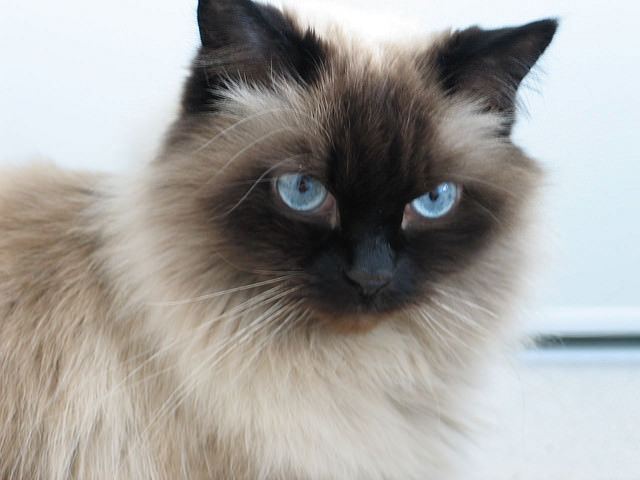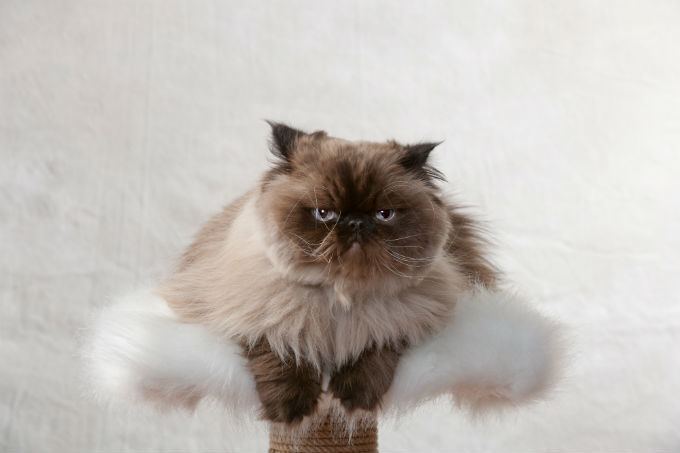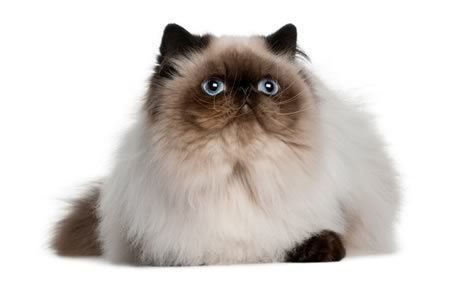Common nicknames Himmy TICA standard ACFA/CAA standard Higher classification Cat | CFA standard AACE standard Scientific name Felis catus Rank Breed | |
 | ||
Other names Himalayan PersianColourpoint PersianLonghaired Colourpoint (obsolete)Siamese–Persian (obsolete) Similar | ||
The Himalayan (a.k.a. Himalayan Persian, or Colourpoint Persian as it is commonly referred to in Europe), is a breed or sub-breed of long-haired cat identical in type to the Persian, with the exception of its blue eyes and its point colouration, which were derived from crossing the Persian with the Siamese.
Contents

History

There is little or no information from the literature or early pictorial representations to indicate how ancient the four main groups of cats are; these being the two varieties of tabby, the single coloured black or white, and the sex-linked orange (marmalade or tortoiseshell cats). In addition, there are other breeds of cat that are more closely controlled by man, such as the Manx, the Persian, Siamese, and Abyssinian, to name but a few.

The Cat Fanciers' Association considers the Himalayan Persian simply a color variation of the Persian rather than a separate breed, although they do compete in their own color division. It was for the color that the breed was named "Himalayan": a reference to the coloration of Himalayan animals, in particular the Himalayan rabbit. It has been suggested that the Persian long-haired cats are descended from Pallas's cat, Felis manul, a wild cat that inhabits central Asia and which is unmarked with spots or stripes and has very long soft fur. There is, however, no osteological or other evidence for this and it is more likely that the long-haired domestic cats are the result of artificial selection for this characteristic by man.

Tests are still being done to discover the descendants of cats such as Himalayans. An example of this research and experimentation is in that of the following: A rare color variant of the American mink (Neovison vison), discovered on a ranch in Nova Scotia and referred to as the ‘‘marbled’’ variety, carries a distinctive pigment distribution pattern resembling that found in some other species, e.g., the Siamese cat and the Himalayan mouse.

Work to formally establish a breed with combined Persian and Siamese traits, explicitly for the cat fancy, began in the United States in the 1930s at Harvard University, under the term Siamese–Persian, and the results were published in the Journal of Heredity in 1936, but were not adopted as a recognized breed by any major fancier groups at the time. Brian Sterling-Webb independently developed the cross-breed over a period of ten years in the UK, and in 1955 it was recognized there as the Longhaired Colourpoint by the Governing Council of the Cat Fancy (GCCF).

Separate US-based breeding efforts had begun around 1950, and a breeder known to sources simply as Mrs. Goforth received breed recognition from the Cat Fanciers Association (CFA) near the end of 1957 for the Himalayan. Early breeders were mostly interested in adding Siamese colouration to long-haired cats, and therefore reinforced the stock by outbreeding to Persians only to retain the Persian trait dominance. However, by the 1960s, some were re-introducing Siamese stock and producing less "Persian-style" cats, In the 1980s, a concerted effort to re-establish the breed along more formally Persian lines ultimately caused the breed to be merged into Persian as a variant in some registries (e.g. in 1984 by CFA), and a decline in the "old" or Siamese-like specimens.
Body
Like Persians more generally, the Himalayan tends to have a round (cobby) body with short legs, which makes it harder for them to jump as high as other cats do. Since the 1960s, however, some have more of a Siamese-like body, and thus do not have this limitation, but may not be acceptable as show cats, depending on the specific breed standards of the organisation in question.
Head
As with other Persians, there are two types of Himalayans, the traditional or doll-face, and the peke-faced or ultra-typed which has the more extreme squashed-looking facial features. The seal-point Himalayan in the photo to the left is doll-faced while the chocolate-point in the title image is peke-faced.
Show Himalayans display a nose break as do peke-faced Persians, and have very large, round eyes with the nose leather directly between the eyes. Breeder or pet Himalayans generally have longer noses than the show cats, and may display a longer muzzle and smaller eyes than the show cats do. All three types of cat are Himalayans, however.
Coat
The bulk of the fur on the body of a Himalayan is white or cream, but the points come in many different colors: Seal (or Black), Blue, Lilac, Chocolate, Red (Flame), and Cream. The points can also be Tabby, Lynx, or Tortoiseshell-patterned.
The Chocolate and Lilac point Himalayans are the most difficult to produce, because both parents must carry the gene for Chocolate/Lilac to produce a Chocolate or Lilac kitten, as the trait is autosomal recessive.
Health
Due to their Persian ancestry, some Himalayans may have the gene that causes Polycystic kidney disease, (PKD); however, a genetic test can reveal which cats carry the PKD gene, so that they may be spayed or neutered.
Like many long-haired cats, Himalayans need to be brushed daily to keep their coats looking their best and healthiest. In addition, they may need their face wiped daily, depending on the cat. Bathing a Himalayan is also recommended by some breeders, to help reduce the amount of oil on the cat's fur and skin.
Temperament
These cats are sweet-tempered, intelligent, and generally very social and good companions. Because of their heritage from the Siamese cats, they tend to be more active than Persians.
Himmies, as fanciers call them, are good indoor companion animals. By and large, Himalayan cats are gentle, calm, and sweet-tempered, and they possess a playful side as well. Like the Siamese, Himalayans love to play fetch, and a scrap of crumpled paper or a kitty toy will entertain them for hours. Himalayans are devoted and dependent upon their humans for companionship and protection. They crave affection and love to be pet and groomed.
